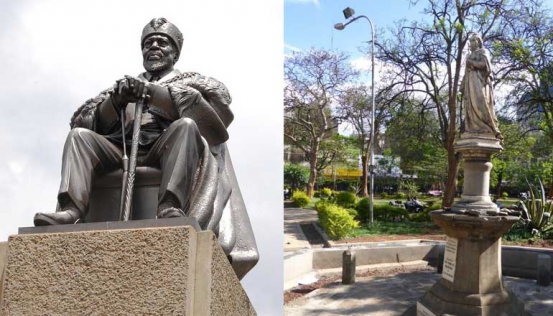
The statues and monuments are not for decoration, but rather, are lasting symbols of identity, ideology, power, domination and commemoration.
In Kenya, the statues of Jomo Kenyatta statue inside Parliament and outside the KICC connoted self-rule and the rallying image of the ‘Father of the Nation’. The ‘interactive’ Nyayo monument in Central Park Nairobi on the other hand, was an insignia of state power.
But did you know our colonial masters used these bronze and marble affairs for other purposes? Before the change of political guard at the cusp of independence in 1963, there were the statues of the Lord Delamere staring down at Nairobians along junction of Kimathi Street and Kenyatta, then Delamere Avenue. It was removed in 1964. It is now squats forlornly in Naivasha where the Delameres have their ranch.
Also removed in Nairobi was the statue of King George V. It had been unveiled in 1945 when World War II ended. The bronze portrait plaque of King George VI at the memorial fountain facing the Kenyatta Mausoleum was also removed. But the fountain remained. It had been unveiled in 1957 as a visual image of colonial power and cultural identity of the Settler community at the height of the Mau Mau insurgency.
“These monuments to British monarchical figures contributed to the construction of a landscape of colonial power,” notes Irish researcher Laragh Larsen in his 2013 essay, Power, politics and public monument in Nairobi Kenya.
“From a post-colonial perspective, the inscription of these monuments into the landscape can be seen as a cultural tool in the project of imperialism” as they were used to assert not only colonial authority, but also Kenya’s place as a loyal member of the British empire. At no time was this best displayed than during the unveiling of the city’s first statue, the Queen Victoria statue inside Jeevanjee Gardens in Nairobi. Alibhai Mullah Jeevanjee, who bequeathed Nairobi the recreational grounds, bankrolled its creation to represent the Queen of Empress of India!
Streets were swept by ‘natives’ who lined from the Nairobi Railway Station to Jeevanjee Gardens where the Duke of Connaught, the first member of the royal family to jet down these shores, unveiled it that March, 1906 when the Gardens “were thronged with enthusiastic crowds, and line on either side by Masai (sic) warriors who gave a most picturesque effect to the whole scene” as The East African Standard reported, adding that game trophies lined untarmacked streets then drenched with water.
Maasais welcoming visitors did not start the other day, but as Ngugi wa Thiong’o posits, ‘power through cultural subjugation was the principal tool of colonialism.’ The African War Memorial Statues and the Obelisk along Kenyatta Avenue were not only unveiled to honour those who died during both World Wars, but also served as linkages to the British in whose war the Africans died!
Little wonder that the best kept graves in Kenya are the War Memorial Cemeteries making us “part of the symbolic landscape of remembrance” with what other parts of the British empire.
In History and Memory published in 1992, French historian Jacques Le Goff argues that “individuals composing a society almost always feel the need to have ancestors and the role of great men is to feel that need” and the statues of Kenyatta (sculpted in England), Mboya, Kimathi, Mundi Mbingu and Paul Ngei are our ‘ancestors’ in patriarchal, post-colonial Kenya.
 The Standard Group Plc is a multi-media organization with investments in media
platforms spanning newspaper print
operations, television, radio broadcasting, digital and online services. The
Standard Group is recognized as a
leading multi-media house in Kenya with a key influence in matters of national and
international interest.
The Standard Group Plc is a multi-media organization with investments in media
platforms spanning newspaper print
operations, television, radio broadcasting, digital and online services. The
Standard Group is recognized as a
leading multi-media house in Kenya with a key influence in matters of national and
international interest.
